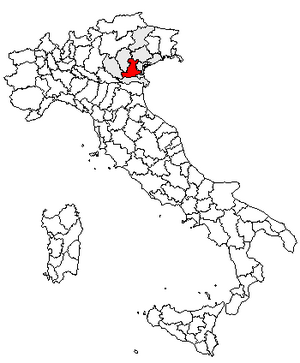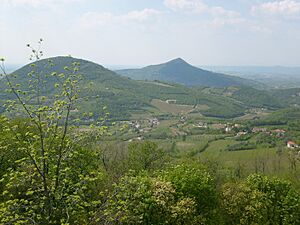Province of Padua facts for kids
Quick facts for kids
Province of Padua
Padua
|
|
|---|---|
 |
|
| Country | |
| Region | Veneto |
| Capital | Padua |
| Area | |
| • Total | 2,142 km2 (827 sq mi) |
| Population
(2001)
|
|
| • Total | 849,857 |
| • Density | 397/km2 (1,030/sq mi) |
| Postal Code |
35010-35032, 35034-35038, 35040-35048
|
| Telephone prefix |
049, 0425, 0429
|
| ISTAT | 028 |
| Vehicle registration | PD |
| No. of communes | 104 |
The Province of Padua (Provincia di Padova) is a cool area in the Veneto region of Italy. Its main city and capital is Padua. This province is a part of Italy, just like a state or county in other countries.
Contents
Exploring the Geography of Padua Province
The Province of Padua covers about 2,142 square kilometers. It is home to 936,492 people (as of 2016). This makes it the most populated province in the Veneto region. There are 102 small towns or districts called comuni within the province.

The land here is mostly flat. It is often divided into different parts. There is the capital city, Padua, and the towns very close to it. This nearby area is called the hinterland. To the north of the city is the Alta Pianura (higher plain). South of the city is the Bassa Pianura (lower plain). This includes the Saccisica area in the southeast.
The only hills in the whole province are the Colli Euganei (Euganei hills). They are located southwest of Padua. All other parts of the province are completely flat.
A Look at Padua's History
The borders of the Province of Padua are very similar to how they were in the Middle Ages. Back then, Padua was a powerful city-state. The area has been managed within these same boundaries for a long time. This includes when the Republic of Venice was in charge. The modern province we see today comes from the administrative divisions of the Kingdom of Lombardy-Venetia.
The Diocese of Padua covers most of the province. A diocese is an area managed by a bishop in the Catholic Church. It even includes some areas from nearby provinces.
Discovering Main Sights in Padua Province
Padua city has amazing art and buildings from the Medieval and Renaissance times. These are periods of great art and learning in history. The towns of Cittadella and Montagnana are famous for their well-preserved city walls. These walls were built long ago to protect the towns.
You can find many beautiful old villas in the countryside. Some of these were designed by the famous architect Palladio. Two main ones are Villa Contarini in Piazzola sul Brenta and Villa Barbarigo in Valsanzibio.
The Euganei hills are a great place to relax in nature. They are often covered in forests. On their eastern side, there are many old spa towns. These are places where people go for relaxing baths in natural hot springs. Some of these towns are Abano Terme, Montegrotto Terme, Galzignano Terme, and Battaglia Terme.
A small part of the Venetian Lagoon is also in the province. It is called the Valle Millecampi (meaning "one-thousand-fields valley"). The river areas in the countryside also have natural paths. You can enjoy cycling or horse-riding there. Traveling by boat is also a fun way to see the area.
Understanding the Climate of Padua Province
Most of the province has a mild climate. It is called a temperate sub-continental climate. This means it has four distinct seasons. Only parts of the Colli Euganei hills have a slightly milder climate. This is because their southern slopes get more sun all year. This allows small olive trees to grow there.
Winters in the province are usually moderately cold. They avoid very extreme temperatures. Frost is very common in the flat areas. There are about 60–70 frosty days each year. Temperatures usually do not drop below -8°C to -12°C in the plains. However, the coldest temperature ever recorded in Padua was -19.2°C in January 1985.
Snowfall changes a lot from year to year. Some winters have almost no snow. Other years have frequent snowfalls. Padua gets about 20 cm (8 inches) of snow on average each year. Fog is also very common, especially in the lower plain. It can sometimes last all day long.
Summers are moderately hot and humid. They are warmer and less rainy in the lower plain. The higher plain often gets thunderstorms. Padua's hottest recorded temperature was +39.8°C in August 2003. Temperatures usually go above +36°C at least once a year.
Spring and autumn are changeable seasons. The weather can be cold like winter or warm and humid like summer. There can be heavy rain or pleasant sunny days. The period between April and June is usually the wettest time of the year.
| Climate data for Padua | |||||||||||||
|---|---|---|---|---|---|---|---|---|---|---|---|---|---|
| Month | Jan | Feb | Mar | Apr | May | Jun | Jul | Aug | Sep | Oct | Nov | Dec | Year |
| Mean daily maximum °C (°F) | 5.7 (42.3) |
8.8 (47.8) |
13.1 (55.6) |
17.5 (63.5) |
22.4 (72.3) |
26.0 (78.8) |
28.4 (83.1) |
27.9 (82.2) |
24.5 (76.1) |
18.8 (65.8) |
11.5 (52.7) |
6.5 (43.7) |
17.6 (63.7) |
| Mean daily minimum °C (°F) | −1.4 (29.5) |
0.5 (32.9) |
3.5 (38.3) |
7.4 (45.3) |
11.6 (52.9) |
15.3 (59.5) |
17.5 (63.5) |
16.9 (62.4) |
13.8 (56.8) |
8.8 (47.8) |
3.7 (38.7) |
−0.4 (31.3) |
8.1 (46.6) |
| Average precipitation mm (inches) | 71 (2.8) |
56 (2.2) |
66 (2.6) |
69 (2.7) |
79 (3.1) |
89 (3.5) |
64 (2.5) |
79 (3.1) |
58 (2.3) |
66 (2.6) |
86 (3.4) |
64 (2.5) |
850 (33.3) |
| Source: Intellicast | |||||||||||||
Sometimes, extreme weather events can happen. Flooding has been a problem for a long time. Because of this, all the rivers and channels are built up with banks. Many new channels were dug to prevent floods. The worst recent floods were in November 1966 and November 2010.
Snowstorms can happen in winter. These bring fresh snow and strong winds called Bora gusts. They are rarely full blizzards. They usually last only 1–2 days and bring about 15–25 cm (6-10 inches) of snow. However, a truly amazing snowfall happened in 1608. It snowed for 40 days straight, from late January to early March. The snow on the ground reached at least 2 meters (6–7 feet) deep! This was even written about by Galileo.
Rarely, between May and September, tornadoes can hit the area. A famous one happened in August 1756, causing a lot of damage in Padua. Another strong one in September 1970 started in the Colli Euganei. It then moved through the Paduan metropolitan area and ended over Venice. Hailstorms are also possible in summer. The worst recent one was in August 2003.
Understanding the Economy of Padua Province
The province has a strong economy. This is especially true in the Paduan metropolitan area and the Alta Pianura. Many different types of businesses are here. Most are industrial, but there are also service and farming businesses. These areas also have a lot of people living there.
The Bassa Pianura is mostly a farming area. It is generally less wealthy and has fewer people. Tourism is popular in the spa towns. However, in Padua and other parts of the province, tourism could grow more. Many pilgrims visit Padua for religious reasons.
Getting Around: Transportation in Padua Province
Two main motorways cross the province. One is the A4, and the other is the A13. Padua also has a highway ring that goes around the city. This ring connects Padua to its surrounding areas.
The main railway lines follow almost the same paths as the motorways. They go to cities like Venice, Milan, or Bologna. There are also smaller railway lines. These go north to Castelfranco Veneto, northwest to Bassano del Grappa and Trento. Others go southwest to Mantua and southeast to Chioggia. The main roads also follow all these important routes.
| Provinces of Veneto |
|---|
| Belluno | Padua | Rovigo | Treviso | Venice | Verona | Vicenza |
See also
 In Spanish: Provincia de Padua para niños
In Spanish: Provincia de Padua para niños




